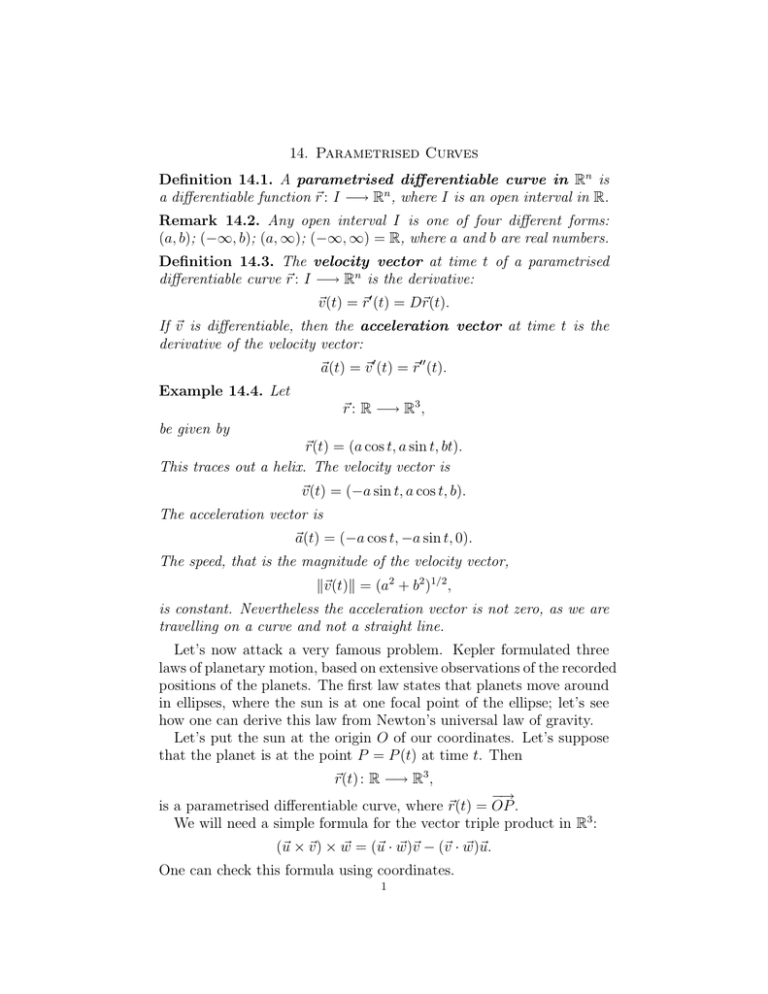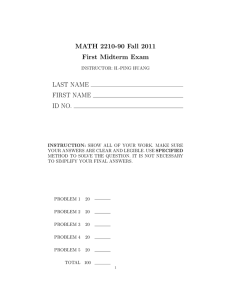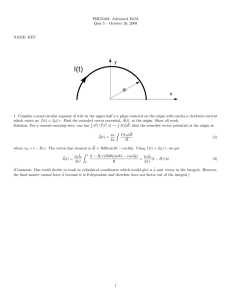14. Parametrised Curves is a differentiable function �
advertisement

14. Parametrised Curves
Definition 14.1. A parametrised differentiable curve in Rn is
a differentiable function �r : I −→ Rn , where I is an open interval in R.
Remark 14.2. Any open interval I is one of four different forms:
(a, b); (−∞, b); (a, ∞); (−∞, ∞) = R, where a and b are real numbers.
Definition 14.3. The velocity vector at time t of a parametrised
differentiable curve �r : I −→ Rn is the derivative:
�v (t) = �r� (t) = D�r(t).
If �v is differentiable, then the acceleration vector at time t is the
derivative of the velocity vector:
�a(t) = �v � (t) = �r�� (t).
Example 14.4. Let
�r : R −→ R3 ,
be given by
�r(t) = (a cos t, a sin t, bt).
This traces out a helix. The velocity vector is
�v (t) = (−a sin t, a cos t, b).
The acceleration vector is
�a(t) = (−a cos t, −a sin t, 0).
The speed, that is the magnitude of the velocity vector,
��v (t)� = (a2 + b2 )1/2 ,
is constant. Nevertheless the acceleration vector is not zero, as we are
travelling on a curve and not a straight line.
Let’s now attack a very famous problem. Kepler formulated three
laws of planetary motion, based on extensive observations of the recorded
positions of the planets. The first law states that planets move around
in ellipses, where the sun is at one focal point of the ellipse; let’s see
how one can derive this law from Newton’s universal law of gravity.
Let’s put the sun at the origin O of our coordinates. Let’s suppose
that the planet is at the point P = P (t) at time t. Then
�r(t) : R −→ R3 ,
−→
is a parametrised differentiable curve, where �r(t) = OP .
We will need a simple formula for the vector triple product in R3 :
(�u × �v ) × w
� = (�u · w
� )�v − (�v · w
� )�u.
One can check this formula using coordinates.
1
Theorem 14.5 (Newton). Suppose that
�a = −
GM
�r,
r3
for some constants G and M .
Then �r traces out either an ellipse, a parabola or a hyperbola.
Proof. We have
d�r
dv
d(�r × �v )
× �v + �r ×
=
dt
dt
dt
= �v × �v + �r × �a
= �0 + �0 = �0,
since �a and �r are parallel by assumption. Hence
�r × �v = �c,
a constant vector. It follows that �r and �v lie in the plane Π through
the origin and orthogonal to �c.
We may write �r = rû, where û is a unit vector.
�v =
d(rû)
dr
dû
= û + r .
dt
dt
dt
It follows that
�c = �r × �v
dr
dû
û + rû × r
dt
dt
dû
= r2 uˆ × .
dt
= rû ×
So
�
� �
�
GM
dû
2
�a × �c = − 2 û × r û ×
r
dt
�
�
dû
= −GM û × û ×
dt
�
�
dû
= GM uˆ ×
× uˆ
dt
�
�
dû
dû
= GM (û · û) − (û · )û
dt
dt
d(GM û)
=
.
dt
2
On the other hand,
d�v
d(�v × �c)
× �c =
dt
dt
�a × �c =
It follows that
�
�v × �c = GM û + d,
where d� is a constant vector. If we cross both sides with �c, then the
LHS is zero and so the RHS is zero. It follows that d also lies in the
plane Π. Define θ to be the angle between d� and �u. Now
��c�2 = �c · �c
= (�r × �v ) · �c
= (�v × �c) · �r
= (GM û + d�) · �r
= GM r + r�d�� cos θ.
Let c = ��c� and d = �d��. Then
c2
GM + d cos θ
p
=
,
1 + e cos θ
r=
where
c2
d
and
e=
.
GM
GM
Let’s express these equations in Cartesian coordinates and not polar
coordinates. We have
p=
x = r cos θ
y = r sin θ.
Therefore
p = r + er cos θ,
so that
p = r + ex.
Solving for r,
r = p − ex.
Squaring both sides we get
r2 = (p − ex)2 .
That is
x2 + y 2 = p2 − 2epx + e2 x2 .
3
Therefore
(1 − e2 )x2 + 2pex + y 2 = p2 .
There are three cases. The conic
C = { (x, y) ∈ R2 | (1 − e2 )x2 + 2pex + y 2 = p2 },
is an
⎧
⎪
if |e| < 1
⎨ellipse
parabola if |e| = 1
⎪
⎩
hyperbola if |e| > 1.
Let’s suppose that
|e|
< 1. First divide through by 1 − e2 ,
2pe
1
p2
2
x
+
y
=
.
1 − e
2
1 − e2
1 − e
2
If we complete the square, then we get
�
�2
pe
1
p2
2
x+
+
y
=
.
1 − e2
1 − e2
(1 − e2 )2
Finally divide through by the RHS to get
�2 �
�2
�
pe
x + 1−e
y
2
= 1.
+
p
p
x
2 +
√
1−e2
1−e2
This is the equation of an ellipse. The centre of the ellipse is at
pe
(−
, 0).
1 − e2
One can check that this means one of the focal points is at the origin.
�
4
MIT OpenCourseWare
http://ocw.mit.edu
18.022 Calculus of Several Variables
Fall 2010
For information about citing these materials or our Terms of Use, visit: http://ocw.mit.edu/terms.

![MA1S11 (Timoney) Tutorial/Exercise sheet 1 [due Monday October 1, 2012] Solutions 1.](http://s2.studylib.net/store/data/010731544_1-a1442b5466f6cee30f7e9fd2174164ff-300x300.png)




